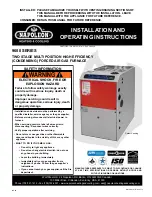
8
4 MAINTENANCE
3.4
AIRFLOW VERIFICATION
Verify the airflow by taking readings of the following points,
while the elements are in the heating mode:
WARNING
x
Total amperage of all the heating elements;
Electrical shock hazard.
x
Voltage at the furnace;
Turn OFF power to the furnace before any disassembly or
servicing.
x
Supply air temperature. The point of the reading must
not be affected by radiant heat from the elements;
Failure to do so can result in death, bodily injury and/or
property damage.
x
Return air temperature.
From these readings, one can arrive at an approximate
calculation of the average airflow. To do that, the following
formulae should be used:
Preventive maintenance is the best way to avoid unnecessary
expense and inconvenience. Have your heating system
inspected by a qualified service technician at regular intervals.
Do not attempt to repair the furnace or its controls. Call a
qualified service technician.
0.82 x amps. x volts
Liter/s= -------------------------
Diff. temperature ˚C
3.1 x amps. x volts
Before calling for repair service, check the following points:
CFM = ------------------------
1) Check fuses or the circuit breaker;
Diff. temperature ˚F
2) Check if the 15 A circuit breaker on the furnace is
disengaged;
3.4.1.
Supply Air Temperature Rise Test
3) Set the thermostat higher than room temperature. If
the unit does not start up, cut the power and call la
qualified service technician.
1) Operate the unit at maximum power for at least 10
minutes;
2) Measure the air temperature in the return air plenum;
When calling for service or ordering a replacement part, specify
the model and serial number of your appliance.
3) Measuring the air temperature in the largest trunk
coming off the supply air plenum, just outside the
range of radiant heat from the heat exchanger. 0.3 m
(12”) from the plenum of the main take-off is usually
sufficient;
4.1
AIR FILTER
The filter supplied with the unit is the disposable type and
should be replaced twice a year. The presence of animal hair,
dust, etc. may necessitate more frequent changes. Dirty filters
have an adverse effect on the performance of the central
heating system.
4) The temperature rise is calculated by subtracting the
return air temperature from the supply air temperature.
If the temperature rise exceeds the temperature specified in
Table 1, p.10, change to the next higher blower speed tap, until
the temperature rise falls to the target or below. If the excessive
temperature rise cannot be reduced by increasing fan speed,
investigate for ductwork obstructions or dirty and improper air
filter.
4.2
MOTOR LUBRICATION
Do not lubricate the blower motor, since it is permanently
lubricated.
CAUTION
It is important to check the airflow and to ascertain that the unit
does not operate above the temperatures specified in the
Technical Specifications (Table 1). This is particularly important
if a cooling coil or a heat pump has been installed in the ducts.
Hi-Limit thermal protectors should never need to engage during
the normal functioning of the appliance. They are strictly
designed to engage during the improper functioning of the
blower or when the filter was improperly maintained.
3.4.2.
Vérification des limiteurs de température
After operating the furnace for at least 15 minutes, restrict the
return air supply by blocking the filters or the return air register
and allow the furnace to shut off on High Limit. The electric
heaters must deactivate themselves one by one before the
warm air temperature exceeds 200˚F
Remove the obstruction and the elements should restart after a
few minutes.
Summary of Contents for SUPREME FEM10-M2401AM-A
Page 12: ...12 FIGURE 6 Wiring Diagram 10 kW with 1 3 HP motor...
Page 13: ...13 FIGURE 7 Wiring Diagram 15 kW with 1 3 HP motor...
Page 14: ...14 FIGURE 8 Wiring Diagram 18 and 20 kW with 1 3 HP motor and 20 kW with 1 0 HP...
Page 15: ...15 FIGURE 9 Wiring Diagram 23 kW with 1 3 HP and 1 HP motor...
Page 16: ...16 FIGURE 10 Wiring Diagram 27 kW with 1 HP motor...
Page 17: ...COMPONENTS AND REMPLACEMENT PARTS 17...
Page 18: ...18 PARTS LIST Exploded View B50002F Please refer to Table 4 p 20...

































